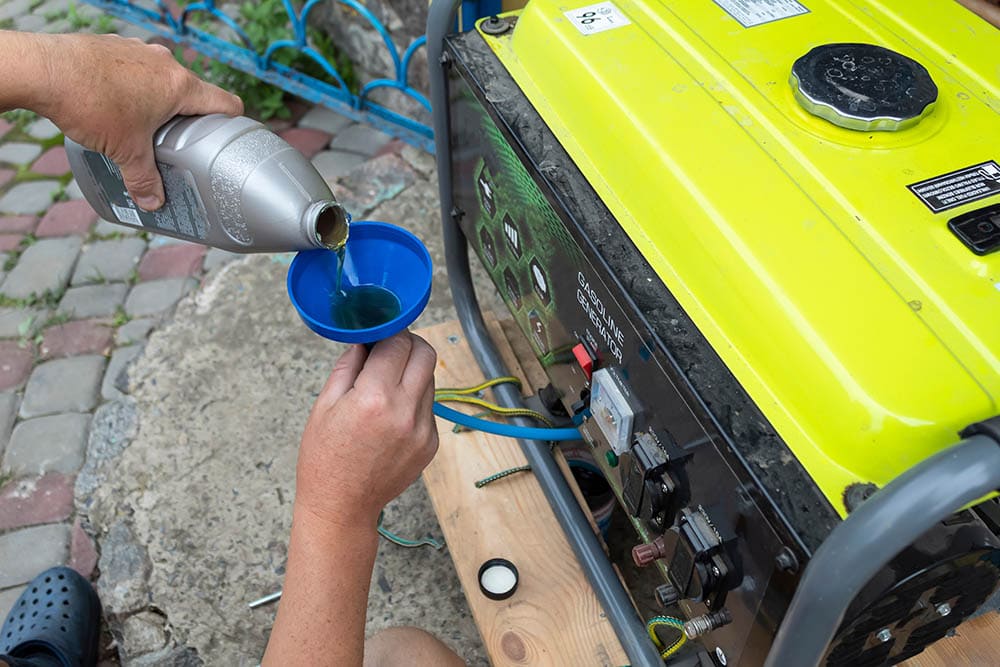What Kind of Oil Does a Generator Take? Comparison, Facts & FAQ
-
Pete Ortiz
- Last updated:

Proper engine maintenance for your generator should always be a priority. A generator is crucial for keeping you comfortable and safe when the power goes out. Without proper upkeep, you’ll be in for some unpleasant surprises when you try (and fail) to turn it on during the next emergency.
Keeping your generator operational is often as easy as storing it properly and staying on top of oil changes. While staying aware of usage and maintaining a changing schedule is crucial, selecting the correct oil is even more vital.
Like most gas engines, generators need different types of oil depending on their style and operating environment. Without considering these factors, you could use the incorrect oil and cause immediate and lasting harm to your engine. To protect your engine from undue wear and inefficiency, follow these tips for choosing the right kind of oil for your generator.
What Kind of Oil Does a Generator Take?
The correct kind of oil depends on the generator you’re using and the operating conditions. Every model will have different oil specifications that lay out the proper viscosity for the ambient temperature.
Generator manuals always include charts with every suitable oil for their engines and the operating temperature for each. For instance, it may recommend 5W-30 oil when the temperature is below 20°F and 10W-30 when it’s above 0°F.
While each model varies slightly, the same general guidelines often apply for choosing the appropriate oil. As you could guess, lower viscosity is preferable as temperature decreases. An SAE 30 or 10W-30 oil will work above-freezing temperatures. Meanwhile, you can use thinner multi-grades, like 5W-30, across a range of temperatures above and below freezing.
It’s generally best to use a multi-grade oil like 10W-30 for a home generator. The same oil can work through a broad temperature range. That means you can respond to power outages without worrying about the startup, regardless of the time of year. If you use a generator on a seasonal basis, such as for camping, you may be able to use a single-grade oil.

Two-Stroke vs. Four-Stroke
It’s crucial to identify whether you have a two-stroke or four-stroke engine in your generator since each kind uses a different oil. In a two-stroke engine, the oil burns with the fuel in the chamber, so it needs a specific formulation to promote combustion and prevent damage.
Oil in four-stroke engines moves from the crankcase around the engine components to cool, clean, and lubricate them before flowing back to the crankcase. These oils contain detergents and other additives to prevent corrosion, reduce friction, clear buildup, and extend the oil life.
Four-stroke engine motor oil isn’t supposed to burn with the fuel. It can have a higher viscosity to last longer and provide better lubrication. Meanwhile, two-stroke oils are designed to burn cleaner to prevent byproduct buildup in the engine.
Using the two types of oil without regard for the engine can cause damage. Mixing in oil for a four-stroke engine will quickly cause carbon to accumulate in the chambers while decreasing efficiency. It will likely cause your machine to smoke and foul various components, such as your spark plugs.
Putting two-stroke oil in a four-stroke engine will also cause issues. Because it’s meant for consumption with fuel, most two-stroke oils are single-grade and have low viscosity. They may work in a pinch, but using them in four-stroke engines will cause performance issues and force more frequent oil changes.
How Often Does a Generator Need an Oil Change?
Most manufacturers recommend changing generator oil within 10–30 hours after its first use. Oil can gunk up quickly from a machine that hasn’t had a cleaning since manufacturing. Engines capture tons of dust, dirt, and other contaminants between production and shipping. An early oil change will help refresh the engine for extended use.
Following the first oil change, you can typically go 50–100 operating hours between oil changes. Diesel generators can run longer between oil changes, often up to 250 hours.
To guarantee lasting performance, check your owner’s manual for information on the proper oil change schedule. You will likely need to change your generator oil more frequently if you operate it under dusty conditions, in extreme weather, or for prolonged periods.
If you’re unsure how much time has passed since your last oil change, it’s always wise to check the oil before you use your generator. Check the oil while the engine is cooled. Add more or change the oil if it’s dirty or depleted.
Even if only a few operating hours have gone by since your last oil change, consider changing it again when the weather has warmed or cooled. Maintaining the proper viscosity for the ambient temperature is critical for a healthy engine and smooth operation.

Choosing the Right Oil for Your Generator
A glance at the owner’s manual and a trip to the local auto store is typically all it takes to ensure you find the best oil for your generator. Follow the manufacturer’s guidelines according to the temperature outside. Check product labels to ensure you purchase oil with the proper viscosity for your engine. Look for certification marks, such as API emblems, to find high-quality and clean-running motor oils.
If you’re unsure whether your generator has a two-stroke or four-stroke engine, check the engine caps. The fill cap on a two-stroke engine will have a fuel and an oil icon with an oil/fuel ratio. A four-stroke engine will have two separate caps, one with a fuel icon and one with an oil icon. Carefully check labels when getting oil to ensure you aren’t buying it for the wrong engine.
In Conclusion
A faulty generator can be disastrous, and it is crucial to stay on top of proper engine maintenance. A reliable startup and efficient operation begin with the oil you use. Use these guidelines for finding the correct kind of oil your generator takes and set a rigid schedule to get the dependable operation you need.
Featured Image Credit: Tonographer, Shutterstock
Contents


